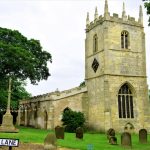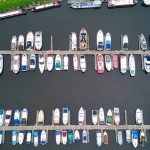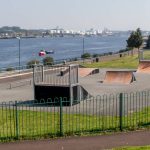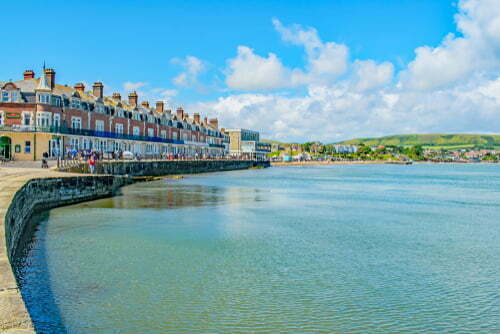
Swanage in Brief
Swanage is a coastal town, seaside resort, and civil parish in the southeast of Dorset, southwest England. It’s located on the Isle of Purbeck, a peninsula on the English Channel, about 6 miles (10 km) south of Poole and 25 miles (40 km) east of Dorchester. The town also happens to be situated at the eastern end of the Jurassic Coast, a UNESCO World Heritage Site. Swanage started out as a small port and fishing village in Saxon times. Later, the quarrying of limestone and marble became important to the town. However, in Victorian times it flourished as a popular seaside resort. The current (2021) population of the town is around 11,500.
A Fleeting History
Early Times
There is archaeological evidence to suggest there was human habitation around the Swanage area as early as 6,000 BC. The first-century Romans were also certainly active in the area. In particular, they were involved in the mining of the distinctive Purbeck marble. They used the decorative stone in building works across southern England.
The first documented history of the town appears in the Anglo-Saxon Chronicles, dated AD 877. At this time Swanage was nothing more than a small fishing hamlet. The historical text notes the presence of a large mill house and pond in the village. Importantly, it also documents a great naval victory for Alfred the Great which took place just off the Swanage coast. The Chronicles record that some 120 Danish ships were sunk during the battle.
The 11th century Norman Conquest of England saw the building of many fine manor houses, churches, cathedrals, abbeys, etc., across the country. This programme of building works triggered an enormous demand for the local Purbeck Marble. Swanage, already known for quarrying limestone also became the local hub for the marble industry. In the centuries that followed, quarrying would be the cornerstone of Swanage’s economy.
Major Developments
The parish of Swanage was created in 1487, which saw St Mary’s adopted as the community church. The building was originally a chapel-of-ease, supporting St Nicholas’s church at Worth Matravers. It is thought St Mary’s dates to the 13th century when it was originally constructed as a defence tower. Today, the church looks very different from the original structure as it underwent significant alteration in the 14th, 17th, 18th, and 19th centuries.
The change that did come was largely due to the Great Fire of London in 1666. The resultant building initiative that followed created a huge demand for Purbeck stone. The high volumes of mined stone meant it was no longer viable to transport it to Poole for shipping. Thus, a quayside was quickly constructed at Swanage to accommodate the local transportation of stone. This enabled the town to develop as an industrial port. However, fishing and quarrying remained the mainstay of Swanage’s economy up until the early 19th century.
Victorian Times
In 1701, local quarry owner, Thomas Chapman built himself a large manor house at Swanage. By the early 19th century the house was owned by local MP William Morton Pitt. He was active in the promotion of Swanage as a holiday resort. He subsequently had his town mansion converted to luxury accommodation, which he named the Manor House Hotel. In 1833, the young Princess Victoria stayed at the hotel, which saw it subsequently renamed the Royal Victoria Hotel.
In 1822, businessman John Mowlem founded a locally-based civil engineering and construction company. However, the majority of the company’s work was in London. Mowlem imported great quantities of Purbeck limestone and marble into the Capital for his projects. In 1843, another local businessman, George Burt, built Swanage Town Hall. Mowlem and Burt soon began to work together to help develop Swanage’s infrastructure. They were responsible for building the town’s first pier, gas works, and waterworks, as well as the Mowlem Institute (a reading room), and the development of the Durlston Estate and Country Park.
In May 1885, a 10-mile branch railway line from Wareham to Swanage was opened. The construction of the line was largely down to the 40 years of constant campaigning by George Burt. The railway helped to greatly increase the town’s visitor numbers, especially those from London. The great influx of tourists generated the need for a second pier in the town. The new pier opened in 1895, to be primarily used by pleasure steamers.
The War Years
The First World War left Swanage relatively unscathed. However, World War Two was a different story as the town was bombed on numerous occasions. Almost all the major attacks took place in 1942, which saw the Luftwaffe bombings kill 20 people in the town. The war also saw the town’s pier put out of action. The landward end was deliberately blown up as part of anti-invasion measures.
In May 1940, a radar development station was built on the Isle of Purbeck close to Worth Matravers. After two years, the radar development work was moved inland to Malvern. The RAF went on to operate the radar at Worth for several years after the war.
Post-war Swanage
In 1948, the town pier was rebuilt so that it could once again accommodate steamer ships. However, post-war Swanage, along with many of Britain’s other seaside resorts, began to see a steady decline in tourist numbers. This was mostly due to the fact that British holidaymakers increasingly began to favour the continent. In 1966, the last steamer departed from the Swanage Pier. This saw the waterfront abandoned and it eventually fell into disrepair. However, in 1994, the Swanage Pier Trust gained ownership of the quay and embarked on a restoration programme. After receiving national lottery funds and raising money locally, the Trust successfully restored and reopened the pier in 1998.
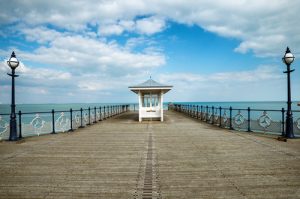
Swanage’s restored Victorian Pier opened in 1998. Image credit: Helen Hotson
The history of Swanage’s railway is not dissimilar to that of the pier. In 1967, the government announced that Swanage’s railway line would close the following year. However, due to legal wrangling, the closure was delayed until 1972. Although the track was partially lifted soon afterwards, a group of local railway enthusiasts formed a charitable trust to fight for the railway to be restored. This ambition was finally realised on 3 January 2002, exactly 30 years after the line was officially closed.
The Modern Era
Swanage’s economy is largely based on the retail and service sector, which includes some tourism. Brickmaking and quarrying are two industries that continue in the construction sector. Some residents commute to Poole and Bournemouth for regular employment.
Swanage, like many seaside resorts, hosts a good number of annual festivals and events. The Purbeck Pirate Festival is scheduled in May and is popular with locals and visitors alike. The equally popular Fish Festival takes place in June. The town’s biggest event is the Regatta and Carnival Week which takes place in the first week of August. As well as sailing, the lively event offers spectacular fireworks, music, and dancing. Music lovers can look forward to the town’s annual jazz, folk, and blues, festivals.
Swanage is twinned with Rüdesheim am Rhein in Germany.
Getting to Swanage
The distance between central London and Swanage is around 120 miles. One of the most direct routes from London is via the M3/M27/A31/A338/B3065/ B3365/B3351. From the Midlands and the North, the most direct route is via the M4/A350/A35 and the A351, which takes you all the way into the town.
The closest mainline train station to Swanage is at Wareham, around 10 miles away. South West trains operate an hourly service from London Waterloo to Wareham. The rail journey from London to Wareham takes around 2 hours 15 mins. Transport options between Wareham and Swanage include the heritage steam train that operates for most of the year. However, there’s also an hourly bus service which takes around 35 minutes.
The nearest airports to Swanage are Bournemouth (BOH) 28 miles away, and Bristol (BRS) 90 miles away.
Did You Know?
- Dating from 1958, ”Divers Down” based on Swanage Pier, is the oldest dive school in the UK.
- During the Victorian Era, Swanage became known as ”Little London”. This was due to the amount of stonework and ironwork inscribed ”City of London” that appeared in the town. Discarded from projects in the capital, the materials ended up being used in the town.
A Famous Resident
The noted British surrealist painter, photographer, writer, and designer Paul Nash (1889 – 1946) lived in Swanage between 1934 and 1936. He is considered a key player in the development of Modernism in the British art movement.
Sport in Swanage
Swanage Town & Herston FC
Swanage Town & Herston FC currently (2021) play in the Dorset Premier League. Nicknamed ‘The Swans’ they play their home games at Days Park.
Swanage & Wareham RFC
Swanage & Wareham RFC is a rugby union team that’s based in Wareham. They currently (2021) play in the Southern Counties South League of the South West Division.
Water Sports
Swanage is a popular area for water sports participation, being home to both a sailing club and a sea rowing club. Swanage Bay also provides a well-sheltered environment for kayaking, canoeing, sailing, windsurfing, and jet skiing. The bay is also a popular location for Scuba diving.
Things to do!
Swanage Railway
Swanage Railway is a charity-owned heritage railway line that runs the 9.5 miles between Swanage and Wareham. A frequent service operates between March and October, consisting of both diesel and steam trains. You might even get the chance to ‘fire’ the boiler or even drive the engine if your luck’s in.
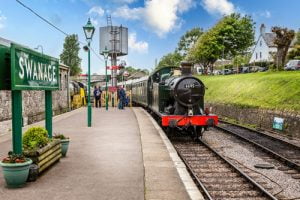
Swanage Railway operates a frequent steam train service. Image credit: Nigel Jarvis
Swanage Museum & Heritage Centre
The museum is located in the Old Market Building (1890) on the Swanage seafront. The exhibits mostly reflect on the human history of the town, as well as the local geology and geography.
Swanage Beach and Pier
The immaculate white sands of Swanage Beach ensure its annual Blue Flag rating. Shops, cafes, restaurants, and amusements can all be found close to the beach on the promenade. There’s also a good range of high-octane water sports available. However, if you’re just looking to chill out, you can hire a rowing boat or a pedalo.
The panoramic seaward views from Swanage Pier can rival the best from anywhere in the country. The pier dates from 1895 and is now owned by the Swanage Pier Trust. The pier has a small gift shop and a museum, complete with an underwater camera that shows off the sea life beneath the structure.
Take a Hike
The 630-mile South West Coast Path passes through Swanage just before it terminates at Poole Harbour, 7 miles away. Whatever direction you decide to walk on the path from Swanage you’re sure to take in some great views.
The Purbeck Way is a 15.5-mile walking route from Swanage to Wareham. The path leads you past Corfe Castle and through a diverse range of natural habitats. Most of the adjoining land is owned by the National Trust, and thus, supports a good variety of flora and fauna.
Things to see!
Old Harry Rocks
Old Harry Rocks are a natural world phenomenon. The three chalk stack formations are located at Handfast Point, about 1.5 miles northeast of Swanage. They are all that’s left of a once continuous line of chalk cliffs that stretched the 20 miles, or so, to the Isle of Wight. They also mark the most easterly point of Dorset’s Jurassic Coast.
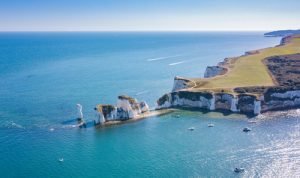
Old Harry Rocks at Handfast Point, near Swanage. Image credit: januszkurek.com/Shutterstock.com
Durleston Country Park
Located within the Jurassic Coast World Heritage Site, Durleston Country Park is 320 acres of coastal scenery. The area bears testament to the Swanage area’s extensive mining past. The visitor centre has a café, restaurant, shop and constantly changing exhibitions.
Corfe Castle & A Model Village
The 1000-year-old ruined castle is perched on a hilltop that overlooks the village of the same name. Destroyed during the English Civil War in 1646, the ruined castle is one of the most popular tourist attractions in Dorset. The castle lies some 5 miles northwest of Swanage.
Located in Corfe Castle village, the model village is a 1/20th scale model of the castle and village as they were 1646. The castle has been replicated to the way it was just before Crowell had it destroyed. The one-acre site also displays related historical artefacts such as stocks and pillories. There’s also a tearoom and gift shop on site.
Tyneham ”Ghost” Village
Tyneham village lies about 10 miles west of Swanage. The area was purchased by the government during WW2, for training purposes. The villagers were promised they could return after the war but they never did. The ghost village, still owned by the military, has seen some buildings fully restored to the way they were in the 1940s. The popular attraction is open to the public at weekends.
Where to stay?
Swanage and the surrounding area offer a full range of accommodation options. Whether you’re looking for a luxury hotel, a holiday cottage, a farm stay, a hostel, a traditional B&B, a holiday park or a basic campsite, you should have no trouble finding it around the Swanage area.
Moving to Swanage?
Properties in Swanage sold for an average price of approximately £384,000 over the last year (Oct 2021). The best selling properties were flats, which sold for an average price of around £260,000. Terraced houses sold for an average price of £338,000, semi-detached properties for £359,000, and detached properties fetched £573,000. Overall, the average sold property price in Swanage over the last year was 4% up on the previous year.
Thinking of a Staycation?
Are you thinking of holidaying in the UK sometime soon? If so, why not check out some of our other travel guides for some staycation ideas? I think you’ll be surprised at the variety of great things to do in the UK’s fairly green and mostly pleasant land.
Header image credit: Kenn Sharp/Shutterstock.com
